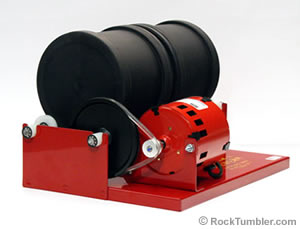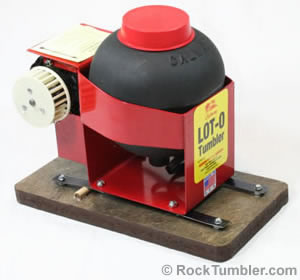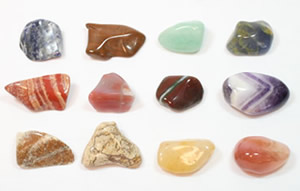How Long Does Rock Tumbling Take?

An example of a rotary rock tumbler. This Thumler's A-R2 tumbler has two three-pound barrels. Rotary tumblers take about four to eight weeks to process a load of rock - one week for each of the following steps: coarse grind, medium grind, fine grind and polish. Some people run their rocks for two or more weeks in the coarse grind to obtain tumbled stones with more rounded shapes and smoother finishes.
The Short Answer
Using a rock tumbler to convert rough rock into polished stones can take as little as one week to as long as two months. The amount of time mainly depends upon the type of tumbler that you use, the type of rocks that you are tumbling and how picky you are about producing nicely-rounded stones.
There are two types of tumblers in common use by people who do rock tumbling: Rotary tumblers (see image at right) and vibratory tumblers (see image at right below).
Rotary Tumblers - 4 to 8 Weeks
Most people who do rock tumbling use a rotary tumbler. With the typical rotary tumbler you seal your rocks in a soft rubber barrel with a grinding compound known as "tumbling grit" and a little water. The barrel then rolls on the tumbling machine for about a week and the rocks tumble inside of the barrel.
Most rotary tumbling is done using a four-step process: coarse grind, medium grind, fine grind (also called the pre-polish step), and polish. Each of these steps takes about one week. So, rotary tumbling generally takes about four weeks.
Some people who want superbly-shaped stones run the rocks in coarse grit for two, three or four weeks. Others inspect every rock after the first step and rerun any that could be improved with additional tumbling.
We are quite picky about our tumbled stones. We want them nicely rounded and we want them free of surface blemishes. So, we almost always tumble them at least two weeks in coarse grit, and sometimes as long as a month when we have large pieces that have ugly shapes at the start.

An example of a vibratory rock tumbler with a 4-pound rubber barrel by Lot-O-Tumbler. Vibratory tumblers process a load of rock in one to two weeks.
Vibratory Tumblers - 1 to 2 Weeks
Most vibratory tumblers have a bowl that is rapidly shaken by a motor. This shaking produces a lot of friction between the rocks in the bowl and results in a rapid removal of material.
Most vibratory tumblers are run for 12 to 24 hours with a medium grit. Then the spent grit and mud are washed from the rocks. This step is repeated until the rocks are nicely smoothed. This usually takes between three and seven days depending upon the type of rock and their starting condition. The rocks are then processed two or three days in fine grit (also called pre-polish), and two or three days with polish. So, vibratory tumbling generally takes between one and two weeks.
Why then doesn't everyone use a vibratory tumbler? The first reason is that a vibratory tumbler costs about 50% more than a rotary tumbler. The second reason is that the grinding step of a vibratory tumbler "smooths" the rocks but does not "round" them like a rotary tumbler does (see rock photo at right). People who like rounded rocks use a rotary tumbler. Those who like angular rocks use a vibratory tumbler.

We polished the six rocks on the left side of this image in a vibratory tumbler (we used a single Lot-o-Tumbler) and the six on the right in a rotary tumbler. Note the difference in their shape. The rocks on the right are nice and round and the rocks on the left are nice and angular. :) Rotary tumblers "round" the rocks while vibratory tumblers simply "smooth" them.
Rotary Followed by Vibratory
Many people use both rotary and vibratory tumblers to tumble-polish rocks. They begin by running the rocks between one and three weeks with coarse grit in a rotary tumbler. This first rotary step rounds the rocks. They then finish the rocks with three steps in a vibratory tumbler.
This rotary-then-vibratory process produces nicely rounded rocks two weeks faster than using a rotary tumbler alone.
If you run a rotary machine and a vibratory machine at the same time, you can produce a new batch of finished stones every one to three weeks. A Thumler's Model A-R12 or a Thumler's Model B rotary tumbler will produce enough rounded rock to feed a single Lot-o-Tumbler vibratory machine.
The Influence of Rock Type
Soft rocks such as calcite, marble, obsidian and fluorite are very soft and shape quickly in a rock tumbler. Calcite and marble (Mohs hardness of 3) might round nicely using coarse grit in just two or three days. Fluorite and obsidian (Mohs 4 and 5.5) might round nicely in four or five days. These rocks require a lot less time than described above because of their low hardness.
Most people tumble harder rocks such as jasper, agate, petrified wood and varieties of quartz which have a Mohs hardness of about 7. These rocks take more time to shape and polish in a tumbler. But the results can be well worth the wait!
Happy Tumbling!
RockTumbler.com Authors
 |
Hobart M. King has decades of rock tumbling experience and writes most of the articles on RockTumbler.com. He has a PhD in geology and is a GIA graduate gemologist. He also writes the articles about rocks, minerals and gems on Geology.com. |

